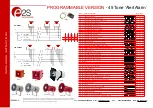
10
A
B
C
OD
(Fr)
OD
at Zero
(Fr)
Taper
Length
(cm)
3
5
8
4
6
8
5
7
8
X
X
X
A
B
C
A
B
C
A
B
C
9. Complete Catheter Insertion
A. Complete catheter advancement into the desired position.
WARNING:
(Pediatric) This is not a right atrium catheter. Avoid positioning the cath-
eter tip in the right atrium. Placement or migration of the catheter tip into the right
atrium may cause cardiac arrhythmia, myocardial erosion
or cardiac tamponade. The risk of these complications may
be more likely in neonatal patients.
NOTE:
Midlines should be positioned with the catheter tip
distal to the shoulder and deltoid muscle.
Caution:
The midline catheter tip location should be at or
near the axillary line [INS, 2016].
10. Retract and Remove the Introducer Sheath
A. Stabilize the catheter position by applying pressure to the vein distal to the
introducer sheath.
B. Withdraw the introducer sheath from the vein and away from the site.
C. Split the introducer sheath and peel it away from the catheter.
Caution:
Do not pull apart the portion of the sheath that remains in the vessel.
To avoid vessel damage, pull back the sheath as far as possible
and tear the sheath only a few centimeters at a time.
11.
Remove the Stylet / T-Lock Assembly
A. Disconnect the T-Lock from the catheter luer connector.
B. Stabilize the catheter position by applying light pressure
to the vein distal to the insertion site.
C. Slowly remove the T-Lock and stylet.
Caution:
Never use force to remove the stylet. Resistance
can damage the catheter. If resistance or bunching of
the catheter is observed, stop stylet withdrawal and allow
the catheter to return to normal shape. Withdraw both the catheter and stylet together
Zero mark


































